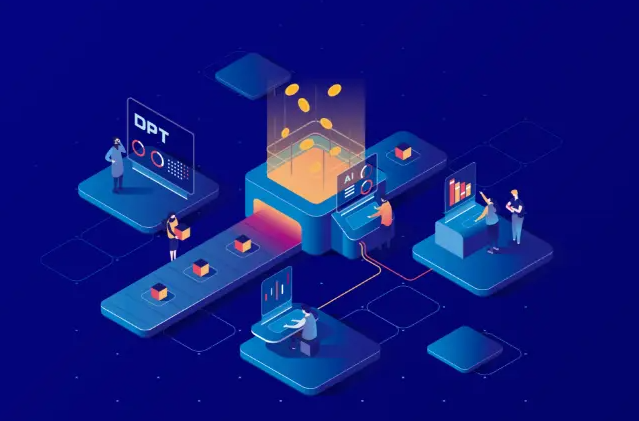
A world where everyday internet users don’t even realize they’re interacting with blockchain. Transactions happen seamlessly, ownership is digital and verifiable, and decentralized apps (dApps) become the backbone of daily life from finance and gaming to social media and healthcare. This isn’t a distant future; it’s the next major technological wave. With Web3 infrastructure maturing and user-friendly platforms emerging, the next billion users will be on dApps and it’s happening faster than you think.
Businesses, startups, and enterprises are racing to tap into this massive shift by investing in dApp development services that allow them to launch scalable, secure, and feature-rich decentralized solutions. Whether you’re a fintech disruptor or a gaming innovator, the dApp revolution offers unparalleled opportunities to onboard the next generation of users.
Understanding dApps: More Than Just Decentralization
Decentralized applications, or dApps, are software programs that run on distributed blockchain networks rather than centralized servers. Unlike traditional apps, where a single entity controls the backend, dApps operate via smart contracts self-executing codes that enforce rules automatically.
Some defining features of dApps include:
- Transparency: Every transaction is recorded on a public ledger, reducing fraud and manipulation.
- Censorship Resistance: No single authority can take down or alter the application.
- Ownership: Users truly own their data, assets, and digital identity.
- Interoperability: Many dApps can seamlessly connect across chains, creating unified ecosystems.
This architecture creates trustless environments that attract users tired of opaque systems. As more people adopt crypto wallets and Web3 browsers, interacting with dApps is becoming as easy as using Instagram or PayPal.
Why The Next Billion Users Will Be On dApps
1. Rising Global Smartphone Penetration
Billions of users in developing countries are coming online via smartphones. Many of these users don’t have traditional banking services but do have internet access. dApps especially DeFi platforms and decentralized wallets are bridging financial gaps by providing accessible financial tools without the need for centralized institutions.
2. Web3 UX Is Improving Rapidly
Earlier, dApps were notorious for clunky interfaces and complicated onboarding. Today, platforms offer gasless transactions, social logins, account abstraction, and integrated fiat onramps making the experience smoother. As user experience approaches that of Web2 apps, mass adoption becomes inevitable.
3. DeFi and GameFi are Driving Mass Engagement
Decentralized Finance (DeFi) has introduced services like lending, staking, and yield farming accessible to anyone with a crypto wallet. Similarly, GameFi projects merge gaming with earning, attracting users globally. These categories already have millions of active users and are projected to explode further.
4. Data Ownership Is Becoming a Global Priority
Post high-profile data breaches and platform bans, users are becoming more privacy-conscious. dApps give users ownership of their personal data and digital assets, offering a compelling alternative to centralized platforms.
Developers Are the Builders of This New Era
The shift to decentralized apps isn’t just about users; it’s also about talent. Companies are aggressively looking to hire dApp developers who can architect innovative, scalable solutions that meet rising demand.
Top developers skilled in Solidity, Rust, Web3.js, and smart contract architecture are shaping applications across multiple industries, including:
- Finance: Creating trustless lending, borrowing, and trading platforms.
- Healthcare: Developing secure patient data systems.
- Gaming: Building play-to-earn economies with NFT integration.
- Supply Chain: Ensuring transparent and tamper-proof logistics.
As organizations pivot towards decentralized ecosystems, the role of skilled dApp developers becomes critical in determining scalability, security, and user adoption.
Industries That Will Drive dApp Adoption
1. Finance and Banking
DeFi platforms are already enabling millions to borrow, lend, and earn interest without intermediaries. With cheaper mobile internet and crypto wallet accessibility, DeFi is poised to onboard users who never had access to traditional finance.
2. Social Media & Content Platforms
Web3 social platforms like Lens Protocol and Farcaster are giving creators ownership of their content and audiences. Users can monetize directly without relying on ad-driven algorithms.
3. Gaming and Entertainment
Blockchain gaming is one of the fastest-growing segments in the dApp world. Players not only enjoy immersive experiences but also earn real-world value from in-game assets.
4. Supply Chain & Logistics
By integrating dApps, supply chains achieve end-to-end transparency, reducing fraud, counterfeiting, and inefficiencies.
5. Healthcare & Identity Management
Decentralized identity and healthcare dApps give users control over their data, allowing secure, consent-based sharing across borders and platforms.
The Backbone of Mass Adoption: Blockchain Development Services
While dApps are the user-facing layer, Blockchain development services form the foundation. Robust blockchain infrastructure ensures:
- Security: Tamper-proof transaction records and smart contracts.
- Scalability: Handling thousands of transactions per second.
- Interoperability: Connecting multiple chains for seamless experiences.
- Compliance: Integrating KYC/AML modules where required.
Enterprises that invest in professional blockchain development gain a competitive advantage by launching reliable, future-proof dApps.
Technological Shifts Accelerating Adoption
1. Layer-2 Solutions
Scaling solutions like Arbitrum, Polygon, and Optimism are reducing transaction fees and latency, making dApps cheaper and faster to use.
2. Zero-Knowledge Proofs (ZKPs)
ZKPs enable privacy-preserving transactions, allowing users to verify data without revealing sensitive information crucial for identity and finance applications.
3. Cross-Chain Bridges
These allow assets and data to move across different blockchains seamlessly, creating connected ecosystems that users can easily navigate.
4. Account Abstraction
This allows users to interact with dApps using familiar login methods and pay gas fees in any token, dramatically improving onboarding.
Global Examples of dApp Success
1. Uniswap
One of the most popular DeFi platforms, Uniswap enables decentralized token swaps and has billions in total value locked.
2. Axie Infinity
A pioneer in GameFi, Axie attracted millions from countries like the Philippines, showcasing how gaming dApps can drive mainstream adoption.
3. Lens Protocol
A decentralized social graph that allows developers to build multiple social apps using the same user-owned data.
4. ENS (Ethereum Name Service)
ENS simplified Web3 interaction by giving users human-readable wallet addresses, accelerating mainstream adoption.
Why Businesses Must Act Now
The Web3 landscape is still early, but the momentum is undeniable. Just as companies that adopted mobile-first strategies early gained a massive edge, businesses that embrace dApps today will dominate tomorrow’s decentralized economy.
The next billion users will not be onboarding to clunky, experimental platforms. They’ll join intuitive, value-driven ecosystems built with scalability and user experience in mind. This is the moment to experiment, innovate, and prepare infrastructure to welcome the flood of users.
Building the Future: Time to Hire Blockchain Developers
To truly capitalize on this next wave, businesses need to hire blockchain developers who understand not only the technical intricacies but also user behavior, security, and compliance. Skilled developers are the bridge between visionary ideas and operational reality.
These professionals:
- Build smart contracts that power core application logic.
- Ensure interoperability between chains.
- Implement advanced cryptography for security.
- Optimize performance for high throughput.
Hiring experienced blockchain developers ensures that your dApp isn’t just functional it’s future-ready.
Conclusion
The decentralized revolution is unfolding before our eyes. From DeFi to GameFi, from healthcare to logistics, dApps are set to transform how we interact with the digital world. With billions of smartphone users entering the internet ecosystem and Web3 becoming more user-friendly, the next billion users will inevitably be on dApps.
Businesses that invest early in dApp development services, leverage reliable Blockchain development services, and hire blockchain developers will be at the forefront of this transformation. This isn’t a passing trend it’s the foundation of a new digital era.
FAQs
1. What are dApps used for?
dApps are used across industries like finance, gaming, social media, supply chain, and healthcare to provide transparent, secure, and decentralized services.
2. Are dApps safe for users?
Yes. dApps run on blockchain networks that use cryptographic methods for security. However, users should ensure they use audited platforms to avoid vulnerabilities.
3. How are dApps different from traditional apps?
Unlike traditional apps that rely on centralized servers, dApps run on decentralized blockchain networks, offering transparency, censorship resistance, and true digital ownership.
4. Do users need to understand blockchain to use dApps?
Not necessarily. Modern dApps offer intuitive interfaces, social logins, and gasless transactions to make onboarding easy even for non-technical users.
5. How can businesses benefit from dApp adoption?
By building dApps, businesses can reduce operational costs, reach global audiences, provide transparent services, and create new revenue streams through tokenomics and digital assets.
